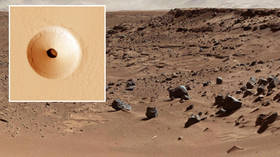Plato called it! Earth is made entirely out of cubes… at least on average

Plato conjectured that the universe was composed of particular geometric shapes and for Earth that was cubes. While that may sound ridiculous, a team of researchers has found that the Ancient Greek philosopher was on to something.
A team of experts in math, geology and physics wanted to know what shapes remain when rocks break into pieces. Stunningly, they found that the average shape of rocks on Earth is a cube.
Beginning with theoretical experiments, they found that when a three-dimensional shape is broken in two and the resulting pieces are broken again, in an average sense, the shape of the fragments that are left over is a cube. Remarkably, the scientists found that the theory unites geological processes throughout the solar system.
“It turns out that Plato's conception about the element earth being made up of cubes is, literally, the statistical average model for real earth. And that is just mind-blowing,” Douglas Jerolmack, a geophysicist at the University of Pennsylvania and one of the researchers, said.
Plato was deeply interested in geometry, famously branding his research institute with the inscription: “Let no one ignorant of geometry enter here.” The researchers wonder if this interest gave him a deep insight into the nature of Earth that has remained hidden for thousands of years.
“One thing we've speculated in our group is that, quite possibly, Plato looked at a rock outcrop and, after processing or analyzing the image subconsciously in his mind, he conjectured that the average shape is something like a cube,” Jerolmack added.
Also on rt.com FROZEN Lego bricks may be missing link in evolution of quantum computers (VIDEO)To test their theories in the real world the team measured thousands of rocks of all shapes, sizes and varieties. Amazingly, no matter where the rock came from or what it had been through, the cubic average was found to hold-up.
The scientists said that discovering that an apparently fundamental rule of nature was handed down across the millennia by an ancient philosopher was an “intense but satisfying experience”.
Like this story? Share it with a friend!















